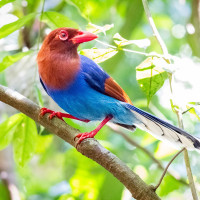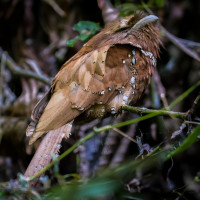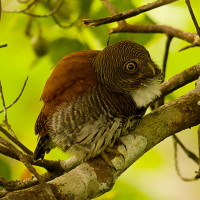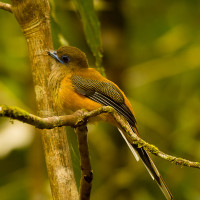Description
Sinharaja Forest Reserve is a birding hotspot in Sri Lanka and the country's last viable area of primary tropical rainforest. The hilly virgin rainforest is part of the Sri Lanka lowland rain forests ecoregion. Over 60% of the trees in this forest are endemic, many of them considered rare. There are two rivers marking the borders of the park, the Koskulana Ganga in the north and the Gin Ganga in the south. Because of the dense vegetation, difficult lighting conditions, and birds that are often high in the forest canopy you have to work hard to see the birds well, and the often cloudy and rainy weather also doesn't help to make it easy. But the birding is exciting and rewarding.
The birds in Sinharaja Forest Reserve tend to move in mixed feeding flocks, invariably led by the Sri Lanka Drongo and the noisy Orange-billed Babbler. Of Sri Lanka's 26 endemic birds, the 20 rainforest species all occur here, including the elusive Red-faced Malkoha, Green-billed Coucal and the stunning Sri Lanka Blue-Magpie. Other commonly sighted endemics are Sri Lanka Grey Hornbill, Black-capped Bulbul, Sri Lanka Frogmouth, Spot-winged Thrush and Ashy-headed Laughingthrush.
Details
Access
The northern entrance of Sinharaja Forest Reserve is situated 120 km southeast of Colombo near the village of Kudawa. The road the the entrance gate and ticket booth is in good condition and easy to drive. You can park in front of the entrance gate. Click on the P in the map for directions of coordinates. The only way to enter the trails in Sinharaja Forest Reserve is on foot, accompanied by a national guide. You can get your ticket at the gate, which is open 6:30-18:00 (last tickets sold at 16.30). The entry fee is 2700 LKR (15 USD, price of 2024). The entrance price includes a local guide, as a guide is mandatory. Do ask for a guide who is specialized in bird watching, this gives you much more focus on birds.
A hike through the forest will generally take about 2,5 hours, but you can choose to walk up to 4 or 5 hours without extra cost. As the forest has plenty of leeches you can buy special anti-leech socks when you buy your ticket (about $ 3 for a pair of socks). If you wear these socks together with long trousers and closed shoes, then you will have little trouble with the leeches. Make sure you bring enough water and snacks as there are no restaurants of any kind in the park. The trail that is indicated on the map is is 4 km one way, but there are several other trails you can explore.
You can also enter the National Park on the southern side (see separate entry on Birdingplaces).
Terrain and Habitat
ForestConditions
Hilly , WetCircular trail
YesIs a telescope useful?
NoGood birding season
All year roundBest time to visit
WinterRoute
Wide path , Narrow trailDifficulty walking trail
Average walkAccessible by
FootBirdwatching hide / platform
NoExtra info
January until March is the best time to visit, as you will avoid the rainy season. April and August to October are still good months to visit, but there might be a bit more rain. But always be prepared for rain!
Close to the entrance are very good options for accommodation. We stayed in Jansens Bungalow (recommended, see the link below) where we had Sri Lanka Blue-Magpie in the garden.




